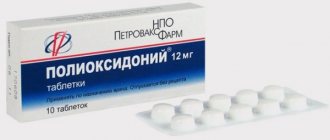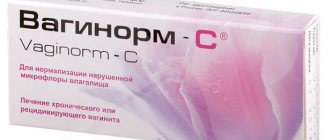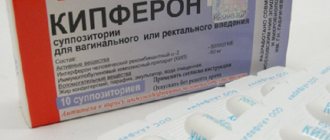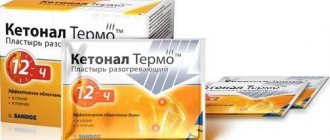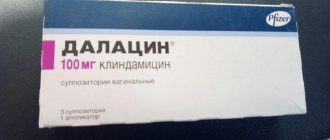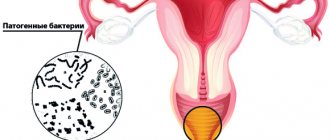- September 27, 2020
- Other drugs
- Ulyana Romanova
Polyoxidonium suppositories, instructions for use of which will be studied in this article, are an immunomodulatory drug. For what conditions is it prescribed? Are there any contraindications? And in accordance with what therapeutic regimen should these suppositories be taken? You will learn about this and much more further.
Composition and price
The active ingredient of the drug is azoximer bromide in an amount of 6 mg. Polyoxidonium suppositories are rectal and vaginal suppositories that have a torpedo shape. They are light yellow and have a faint smell of cocoa butter (it is included in the composition).
There are also auxiliary components - mannitol and povidone.
It is important to know that the drug “Polyoxidonium” 12 mg is also commercially available. These suppositories contain 2 times more active ingredient.
As for the cost, a package of 10 suppositories costs about 1000 and 1200 rubles - with 6 mg and 12 mg, respectively. The exact cost depends on the region and pharmacy.
Polyoxidonium: price and sale
Polyoxidonium is a very common drug because it is very well known. You can buy Polyoxidonium in an online pharmacy, and it is also on the list of drugs that can be purchased at any pharmacy. Advice regarding the purchase of the drug consists of the following warning - you should not take risks and purchase this drug, as well as other medications, from your hands or through friends. To eliminate the risk of purchasing a counterfeit, it is better to buy Polyoxidonium in official medical institutions where a certificate is available indicating the quality of the product. Polyoxidonium, the price of which is the same almost everywhere, is a completely affordable drug.
The drug Polyoxidonium, reviews of which are mostly positive, still has some contraindications. Therefore, you should take the drug only after the approval of your doctor.
Impact on the body
The active substance of Polyoxidonium suppositories (6 mg or 12 mg) has a complex effect on the body. It has anti-inflammatory, immunomodulatory, antioxidant and detoxifying effects.
Thanks to azoximer bromide, the body's resistance to generalized and local infections increases significantly.
This substance helps restore immune responses that accompany secondary immunodeficiency states. Those are usually caused by infections, neoplasms, burns, injuries and complications after operations and treatment with steroid hormones, cytostatics and chemotherapeutic agents.
The mechanism of the immunomodulatory effect is based on the effect exerted directly on natural killer cells and phagocytic cells. Plus, azoximer bromide helps stimulate antibody formation and reduce inflammatory reactions by normalizing the synthesis of anti-inflammatory cytokines.
What determines the antioxidant and detoxifying properties of the product? Its high molecular nature and structure. The active substance helps block soluble toxic compounds, as well as microparticles, and also removes heavy metal salts from the body, inhibiting lipid peroxidation.
It is worth mentioning that azoximer bromide is well tolerated by the human body. It does not have antigenic properties, polyclonal or mitogenic activity, and also does not have carcinogenic, teratogenic, embryotoxic, mutagenic or allergenic effects.
Polyoxidonium: properties and functions
The immunomodulator Polyoxidonium, reviews of which are mostly positive, has proven itself not only in monotherapy, but also in complex treatment. This reduces treatment time and affects its effectiveness. This drug has the following main properties:
— promotes stimulation of phagocytic cells, while stimulating the process associated with antibody formation; — increases the activity of natural killer cells; - helps restore immune responses in secondary conditions of immunodeficiency; - has detoxifying properties; — increases the resistance of cell membranes to the influence of drugs; — increases the period of remission; - reduces the need for antibiotics, bronchodilators and corticosteroids.
The drug Polyoxidonium, reviews of which confirm its high effectiveness, can normalize the state of the immune system after radiation damage. The drug is effective after hormonal therapy, surgery, various injuries, burns and in the presence of malignant tumors.
Pharmacokinetics
When studying the instructions for Polyoxidonium candles, you need to pay attention to this topic. Azoximer bromide has a high bioavailability of at least 70%.
The maximum concentration of the substance after rectal administration is achieved after just 1 hour. The half-life of distribution lasts 30 minutes. There is no cumulative effect.
In the human body, the drug is hydrolyzed to oligomers - they, in turn, are excreted by the kidneys. And the half-life is 36.2 hours.
Pharmacokinetics and pharmacodynamics of the drug
The main task of azoximer bromide is to increase the ability of the immune system to resist the negative effects of pathogens. For example, bacteria, viruses and infections. Thanks to the drug, immune reactions are restored if secondary damage by pathogens occurs.
The active substance works by stimulating the production of antibodies; also, due to the normalization of cytokines, the intensity of inflammation is reduced.
The molecular nature of the drug determines its antioxidant properties. Polyoxidonium has a pronounced detox effect on the body, since it successfully blocks toxic substances.
Polyoxidonium is well tolerated by patients, and when administered rectally, maximum bioavailability is achieved. The maximum concentration in the blood is approximately 60 minutes, and is excreted from the body through the kidneys.
Indications
The instructions for Polyoxidonium suppositories state that this drug is prescribed as a complement to the complex therapy of infectious and inflammatory diseases. It helps to cope with fungal, bacterial and viral pathologies that are in the stage of exacerbation or remission.
In general, the list of indications looks like this:
- Inflammation of the urogenital tract. These are urethritis, bacterial vaginosis, cystitis, cervicosis, pyelonephritis, salpingoophoritis, prostatitis, cervicitis, colpitis, endomyometritis, etc.
- Rheumatoid arthritis, occurring with a viral, fungal or bacterial infection that develops due to long-term use of immunosuppressants.
- Acute and aggravated infectious and inflammatory diseases (fungal, viral and bacterial etiology).
- Tuberculosis of various forms.
- Allergic diseases, including atopic dermatitis, bronchial asthma and hay fever.
- The need to activate regeneration processes in fractures, trophic ulcers and burns.
- Oncological diseases, the treatment of which includes radiation and chemical therapy. Suppositories "Polyoxidonium" help reduce hepato- and nephrotoxic manifestations from these procedures.
But that is not all. This medication may be prescribed as the only drug - for monotherapy. Such indications of Polyoxidonium candles include the following conditions:
- Prevention of recurrent herpes infection.
- Correction of secondary immunodeficiencies that arise due to exposure to adverse factors and aging.
- Seasonal prevention of exacerbations of chronic infectious foci.
- The pre-epidemic period, which is especially important for immunocompromised individuals. At this time, they need to prevent acute respiratory infections and influenza.
But even if the instructions for Polyoxidonium suppositories list the conditions that you have been diagnosed with, you should not start self-medication. Any drug can only be prescribed by a qualified doctor, because after studying the tests and the condition of his patient, he will understand whether this drug will help him or not.
Polyoxidonium for children
In pediatric practice, the use of tablets is allowed from the age of 3, suppositories are used from the age of six, and lyophilisate is used from six months.
For children, Polyoxidonium is prescribed as an addition to the main therapy. Indications for use are acute and chronic infectious and inflammatory diseases (including acute respiratory viral infections and ENT diseases ), allergies and toxic-allergic conditions , complicated by chronic infectious processes in the respiratory tract, bronchial asthma , occurring with complications (including complicated by purulent infection) atopic dermatitis, dysbacteriosis .
For children included in the “ChBD” group, the drug is used to speed up the process of their rehabilitation. In addition, Polyoxidonium has a preventive effect against influenza and colds .
Tablets are taken sublingually or orally at a dose of 6 mg (half a tablet), daily, with a frequency of applications 1, 2 or 3 times a day.
The optimal dose, number and frequency of injections are determined depending on the diagnosis and age of the child:
- For acute inflammatory diseases, five to seven injections are recommended every other day. Dose: 100 mcg/kg. If the disease is chronic, the dose is increased to 150 mcg/kg. The drug is administered every other day. The course involves the administration of up to ten single doses.
- For the treatment of allergies and toxic-allergic conditions, drip administration of the drug into a vein at a dose of 150 mcg/kg is indicated. Therapy is supplemented with the prescription of Clemastine and other drugs that have an antiallergic effect. If the disease occurs with complications, injections are prescribed as an addition to basic therapy. The patient is indicated for 5 intramuscular injections at a dose of 100 mcg/kg. The interval between administrations is 1-2 days.
A solution for intramuscular administration is prepared by dissolving 3 mg of the drug in 1 ml of NaCl solution (water for injection can be used).
A solution for intravenous administration is prepared by diluting 3 mg of the drug in 1.5-2 ml of NaCl solution, 5% glucose solution, Polyglucin or Hemodez , after which, under sterile conditions, it is added to a bottle with one of the indicated solutions in a volume of 0.15-0.25 l.
Intranasal Polyoxidonium is used daily for five to ten days, instilling it at least 3-4 times a day into each nostril in a dose of 1 to 3 drops. The daily dose is 150 mcg/kg body weight. The interval between procedures is 2-3 hours.
To prepare a solution for topical use, add 1 ml (equivalent to 20 drops) of liquid at room temperature (0.9% NaCl solution, distilled or ordinary boiled water) to 3 mg of the drug.
For children, the solution is prescribed at a dose of 150 mcg of the active substance per kilogram of body weight (this amount is contained in one drop of the solution).
The drug is prescribed to be taken sublingually daily for 10 days. The daily dose for all indications is 150 mcg/kg. If the drug is used to treat dysbiosis, the course usually lasts from 10 to 20 days.
The solution is stored in the refrigerator for no more than one week. Before instilling the drug, the pipette with the solution must be warmed to room temperature.
According to the instructions for suppositories for children, the drug in this dosage form can be used rectally to treat patients over 6 years of age. According to the doctor’s indications, suppositories are administered one at a time daily or every other day before bedtime.
Polyoxidonium suppositories for children - reviews confirm this - are an effective remedy, however, the desired effect from their use can only be achieved in cases where the treatment regimen is selected by an experienced doctor and takes into account the characteristics of the disease and the body of a particular child.
Contraindications
They also need to be given attention before discussing the regimen for taking Polyoxidonium suppositories. These suppositories should not be used in the following cases:
- Acute renal failure.
- Pregnancy or lactation period.
- Hypersensitivity to the components of the drug.
- Too young (under 6 years old)
The drug can be used with caution in cases of chronic renal failure. However, then suppositories are used no more than 2 times a week, and only under the supervision of a doctor.
Use among pregnant women and nursing mothers
Since data on the safety of the drug Polyoxidonium for the mother and fetus have not been provided, and there is no clinical experience with the use of suppositories, this drug is not prescribed for the treatment of pregnant women.
This drug is not used among nursing mothers, since the safety of the drug and its ability to be excreted in breast milk is unknown. If treatment is necessary, a nursing mother should stop lactation.
Dosage and method of administration
Now we can move on to this topic. Usually. Use 1 suppository once a day - rectally or intravaginally. However, the exact method and dosage regimen is always determined by the doctor, taking into account the severity, severity of the process and the diagnosis itself. It is allowed to use suppositories daily, every other day, or twice a week.
There are some recommendations regarding the dosage of Polyoxidonium suppositories:
- Suppositories 12 mg can be used by adult patients both intravaginally and rectally. The same applies to a drug with a smaller amount of active substance in the composition.
- The instructions for using Polyoxidonium suppositories for children are different. They can only use them rectally, and after reaching the age of 6.
- Suppositories should be administered only after cleansing the intestines. If the intravaginal method is used, the procedure must be performed at night, immediately before bed, in a lying position.
The standard regimen of use involves daily use of 1 suppository for 3 days. Then the patient should do this every other day with a course of 10 suppositories.
If the doctor considers it necessary, he may prescribe a repetition of therapy, but only after 3-4 months.
Patients suffering from chronic immune deficiency are forced to undergo a long course. It lasts from 2-3 months to 1 year.
Recommendations for use
Polyoxidonium tablets are taken orally or sublingually 1 to 3 times a day, depending on the doctor’s prescription. It is important to take the drug half an hour before meals. Experts recommend adults take 1 tablet, and children under 10 years old take 0.5 tablets at a time.
The course of treatment with lyophilisate is 5 to 10 injections. The first 3 injections of Polyoxidonium are carried out daily, and the subsequent ones once every 2 days. Other options for prescribing the drug are possible, depending on the nature and severity of the disease.
Suppositories can be used vaginally or rectally. For the last option of administration, it is important to first cleanse the intestines. The treatment regimen is as follows: for the first 3 days, 1 candle, and then in the same amount, but every 2 days. One course of therapy will require 10 suppositories.
special instructions
They also need to pay a little attention, studying the instructions for using Polyoxidonium suppositories for children and adults. Here is some information you should know before starting therapy:
- If the result is achieved and the doctor allows you to stop taking the drug, then you can do it immediately. There will be no withdrawal symptoms.
- If the patient accidentally misses a single dose, then it should be taken as soon as possible. But without increasing one dose per dose!
- If allergic reactions develop, you must immediately stop using the product. And be sure to contact your doctor.
- If there are visual signs that the drug is unsuitable (for example, a changed color of the candles or a packaging defect), then you do not need to use it.
- Children can take suppositories from 6 years of age. But for everyone under 18, they are administered only rectally - not intravaginally.
- The drug does not affect attentiveness and ability to concentrate. Therefore, a person can safely continue to drive a car, maintain machinery and perform other work that requires speed of psychomotor reactions.
- This medication is compatible with most medications. Antibiotics, antihistamines, antifungals, antiviral drugs, as well as cytostatics and corticosteroids, including.
- Thanks to experimental studies, it was possible to reveal that the drug does not have a teratogenic or embryotoxic effect. However, there is no clinical experience with the use of suppositories in pregnant and lactating women.
- If a person has kidney or liver disorders, then suppositories should be prescribed with caution.
In general, even though the drug seems quite harmless, there is no need to get carried away with self-medication. There are nuances that the patient simply cannot know about.
Polyoxidonium and Transfer Factor
Polyoxidonium, the price of which is about 1000 rubles for 10 suppositories, therefore, a full course will require approximately 3000 rubles, since the course of treatment involves taking about 30 suppositories. In order to achieve results, this therapeutic course may have to be repeated several times. Transfer factor, which performs the same functions, costs about 2000 per pack of 90 capsules, has no contraindications and has no adverse reactions. In addition, its effect on the body is far superior to that of other drugs known to medicine today. Transfer factor eliminates damage in the DNA chain itself and supplies the immune system with the necessary information, while eliminating the very cause of the disease. It is very effective to use Transfer Factor together with other drugs, including Polyoxidonium, since this is the person’s choice, because Transfer Factor has the ability to neutralize all the side effects of other medications and improve all immune processes in the body.
Drug in tablets
This medication is also available in this form. It is logical that some people ask the question: which is better – Polyoxidonium tablets or suppositories? So, it's worth figuring it out.
The tablets, each containing 12 mg of azoximer bromide, are used to treat the following conditions:
- Infectious diseases of the upper respiratory tract.
- Prevention of influenza and ARVI.
- Allergic conditions involving a fungal, bacterial or viral pathogen.
- Protracted uncorrectable infectious diseases.
- Insufficient immune response.
- Herpes.
And here’s how tablets are clearly similar to suppositories:
- Both forms are used for similar conditions.
- Both suppositories and tablets have the same pharmacological effectiveness.
- Minimal side effects.
- An allergic reaction may develop.
- The cost of a course of treatment is approximately the same.
The differences, in turn, are as follows:
- Mode of application. Not everyone is comfortable with the rectal or vaginal method, and for some reasons it is sometimes impossible.
- “Polyoxidonium” in suppositories is distributed throughout the body faster.
- Suppositories can be taken by children from 6 years of age, but tablets are allowed only from 12 years of age.
Tablets can be prescribed to a patient if he is allergic to the auxiliary components of suppositories. But in general, they are often prescribed along with suppositories to enhance the therapeutic effect.
pharmachologic effect
Polyoxidonium belongs to a group of drugs with an immunomodulatory effect. Under the influence of Polyoxidonium, the body's resistance to various infections and viruses increases. The drug stimulates phagocyte cells and promotes the production of antibodies.
The drug restores the patient’s immunity after infectious diseases, surgical interventions, injuries, burns, antibiotic therapy and therapy with cytostatics and hormones.
The drug has a pronounced detoxifying effect, protects body tissues and cells from the negative effects of free radicals and carcinogens.
The use of Polyoxidonium suppositories as part of complex therapy in the treatment of cancer can reduce the side effects of chemotherapy and radiation therapy - vomiting, nausea, impaired liver function, diarrhea.
The use of this drug in conjunction with glucocorticosteroids and antibiotics makes it possible to reduce the dose of the latter and the duration of the course of therapy, thereby significantly reducing the risk of side effects.
The drug is well tolerated by patients and does not have teratogenic, embryotoxic, mutagenic or carcinogenic effects.
Analogs
If for some reason you cannot find the original drug, you have to look for a replacement. An analogue of Polyoxidonium suppositories should also be selected by a doctor. And here are the most popular alternatives:
- "Galavit." These suppositories have pronounced immunomodulatory, antifibrinolytic and anti-inflammatory effects. The composition contains sodium aminodihydrophthalazindione, which regulates the phagocytic activity of macrophages. This substance destroys pathogens and helps eliminate viruses. It also exists in powder form for the preparation of an injection solution.
- "Imunofan". It has cytoprotective, immunostimulating and antioxidant effects. The composition forms an oligopeptide imunofan (90 mcg), which inactivates superoxides and free radicals. It is also available in the form of a nasal spray and injection solution.
- "Ruferon-RN". Pharmacologically, it is an immune stimulant with antiviral activity. The antibacterial effect is associated with an increase in phagocytic activity, which is characteristic of lymphocytes. The composition is formed by human recombinant alpha interferon.
- "Viferon". Another immunostimulating and antiproliferative agent with interferon in its composition, which affects the reproduction of bacteria and the replication of viruses. This product is also sold as a gel and ointment for external use.
- "Kipferon". The composition of this medication consists of interferon and immunoglobulins. These suppositories have antiviral, antichlamydial and immunomodulatory effects. Also used in children's and adult practice. The exception is the first trimester of pregnancy and lactation.
- "Longidaza". These suppositories are distinguished by enzymatic (hyaluronidase) activity, as well as anti-inflammatory, antioxidant, chelating and immunomodulatory effects. The effect, by the way, is prolonged.
These analogues of Polyoxidonium suppositories also activate the body’s defenses and help cope with the diseases listed earlier. But their use must be approved by a doctor.
Analogues of Polyoxidonium
Level 4 ATX code matches:
Ridostin
Roferon A
Leukogen
Genfaxon
Estifan
Septilin
Inferon
Neupogen
Lipoferon
Laifferon
Sodium nucleinate
Intron A
Betaferon
Neupomax
Granocyte
Gepon
Imudon
Lavomax
Grippferon
Immunal
Analogs of the drug by mechanism of action: Actinolysate , Anaferon , Arpetolide , Arpeflu , Affinoleukin , Bestin , Bioaron Broncho- , Vilozen , Gepon , Gerbion , Glutaxim , Isofon , Immunal , Immunofan , Neuroferon , Ribomunil , Taktivin , Florexil , Cycloferon , Cytovir- 3 , Engistol , Polymuramil , Ismigen .
Reviews
Lastly about them. There are a lot of reviews left about Polyoxidonium candles. Not surprising, because the drug is quite popular. And here are the impressions you see most often in these comments:
- The product really enhances the body's natural defenses, helping it actively fight viruses.
- With this medication, the disease is much easier to bear because it helps eliminate toxins.
- The suppositories themselves are of high quality - they do not leak or smear.
- Unlike some other candles, these are very easy to use. They do not cause the slightest discomfort or burning sensation.
- Literally two days after the start of treatment for the disease, the condition improves - activity and vigor return.
- The remedy helps not only to cure a serious infection, but also to avoid unpleasant consequences.
And there are dozens of such comments. The reviews left about Polyoxidonium suppositories make it possible to verify that the medicine really justifies its price.
Speaking of the cost of the medicine! People do not consider it a disadvantage, assuring that it is better to spend money on a high-quality drug that will get you back on your feet in a matter of days, than to be treated with cheap “dummies” that can only make things worse.
Reviews for Polyoxidonium
Reviews about the drug are mostly positive. This is due to the fact that it effectively treats chronic and complicated diseases that cannot be treated with standard therapy.
Reviews of Polyoxidonium suppositories, tablets and solution are evidence of the effectiveness of each of these dosage forms. When using the drug in complex therapy, the patient recovers faster, and the disease proceeds in a much milder form.
Using the medicine as a prophylactic agent for children can reduce the incidence of diseases. Reviews from doctors about Polyoxidonium allow us to conclude that this remedy is truly irreplaceable.
Prescribing suppositories, tablets or nasal solution to children promotes faster adaptation to being in a group (at school or kindergarten). At the same time, children are much less susceptible to infections even during periods of seasonal epidemics.
Most of the positive reviews of Polyoxidonium in suppositories and other dosage forms are due to the fact that the drug is easy to use, well tolerated by children and practically does not cause side effects.
For adults, Polyoxidonium is most often prescribed for the treatment of infectious diseases. The use of suppositories in gynecology in combination with basic therapy not only helps to effectively eliminate the symptoms of the disease, but also significantly increases immunity and, accordingly, helps prevent relapses and complications.
Having analyzed reviews of Polyoxidonium injections, we can confidently say that the drug has a positive effect even in quite complex cases when the patient’s body is weakened by cancer and its treatment.
Rare negative reviews are due to the fact that the drug did not produce visible changes in the patient’s condition, which in some cases may be the result of an incorrectly selected dosage regimen that does not take into account the individual characteristics of the patient’s body.
Reviews note the high cost of Polyoxidonium, however, given that the drug is effective, helps quickly and for a long time, eases the course and reduces the incidence of diseases, does not cause pain when administered (this applies to all dosage forms with the exception of injections, the latter, on the contrary, are very painful) , this “disadvantage” fades into the background for most patients.


